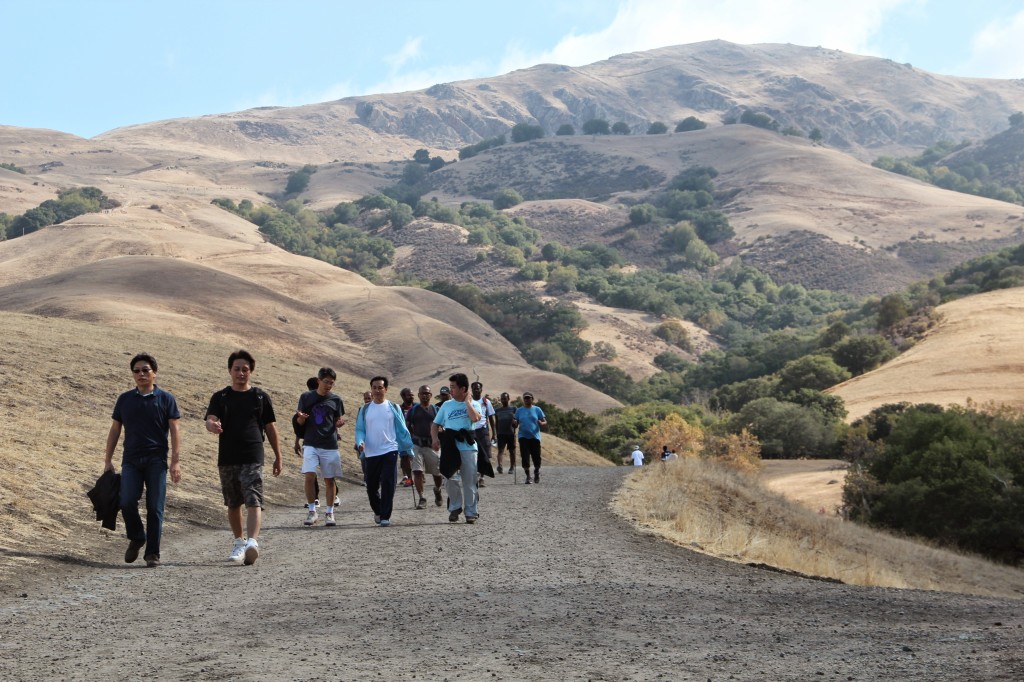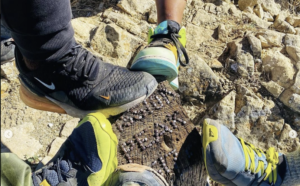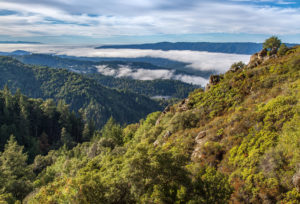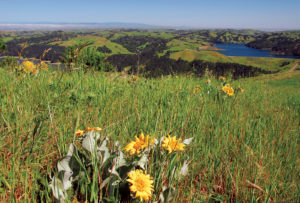Hiking up to Mission Peak on the outskirts of Fremont, I passed a woman with a small dog peeking out of her backpack and a group of teenagers, an elderly couple, and a mother cow with her baby calf.
As the path continued, a few wild turkeys flapped in the distance as another hiker stopped to take a photo. Trekking higher, after switchbacks and a rocky climb, the view from the top of the peak was worth the two-hour uphill journey.
Apparently other people suddenly think so, too. No one can say exactly why, but hiking to the top of Mission Peak, where a pole anchors the top, has become a thing these days. And no journey that exhausting (or exhilarating) can apparently be complete in this day and age without sharing the moment on social media.
Mark Ragatz, the interim chief of park operations at the East Bay Regional Park District, believes the numbers have been building for the last three to four years, but really “took off” last year. In December, the park service installed a device to count the number of people, and summed up an average of 22,700 visitors a month, or about 750 a day from December to August 2014. On some days, hikers wait up to 30 minutes to get a picture on the pole.
“You would expect numbers to drop off in the winter,” Ragatz said, but this was not the case for Mission Peak.

Normally, park personnel are happy to see people getting out and using their trails. After all, that’s one of the ways the conservation community makes its case for park funding and expansion. And although this cliché has been trotted out repeatedly in the Mission Peak debate, it is true that there can be “too much of a good thing.”
Noise complaints from local residents, illegal parking on neighborhood streets and a desire from the park service to preserve and maintain the area, has led the EBRPD to decrease hours at the park’s Stanford Avenue entrance (one of two main entry points to the park) from 6:30 am to 7:30 pm until the end of October. Curfew hours have been in effect since July, and the park district means to enforce them. In the second half of July, 327 citations were given to those descending the peak after 10pm, and another 200 warnings for people arriving at the park after 10pm.

Local media may blame the “Selfie Generation” for the Peak’s rise in popularity, but more than photography brings people to Mission Peak. Paragliding, training for more strenuous journeys, family outings and a view from the top are just a few of the reasons Bay Area residents frequent the park. Still, Ragatz believes social media has driven some change in the demographics, with a trend toward a younger population. There are more than 88,155 tags using the hashtag “Mission Peak” on Instagram.
“[An] awful lot of people are tweeting and using Instagram,” Ragatz said. He describes the photos as “Hey, I’m on top of the world” kind of pictures.
Brian Johnson, who came from San Jose to hike for his fourth time, said he found out about the park through videos and social media, but he didn’t come for the sole purpose of picture taking. “It’s in a convenient location” and it’s “a challenging workout,” he said. Hiking with him was Bianca Brown of Fairfax.
“I just think hiking, in particular, has become more popular,” she said.
The park’s location has attracted people from several cities in the Bay Area, with users coming from Mountain View and San Jose to Oakland and Pleasanton. Increased popularity has meant that the 47 parking spots near the Stanford Avenue entrance sometimes fill up before 6 am as hikers park in the neighborhood. The local residents, Ragatz said, “can’t have a birthday party or relatives come and stay because there’s never any place to park.”
“Ten years ago the cars were just in the parking lot. Now the whole neighborhood is full of cars,” said Stella Wu, who has lived close to the park for the last five years.
Parking is not the only problem; unprepared hikers without enough water or adequate shoes have also been a burden on local emergency services.

For some, Mission Peak has something other places do not. Greg Grothaus lives in San Jose and works in Mountain View, but began going to Mission Peak on a regular basis in January to train for Mount Rainer. It came down to “either a nice park or a stair master,” Grothaus said. He said Mission Peak is particularly appealing to him because of the steep grade, and the parks closer to his house all close at sunset. For him, “the new hours make it relatively impossible” to hike from the Stanford Avenue entrance, a sign that the park district’s new regulations may, indeed, be effective in curtailing the stampede.
After we climbed roughly 2,000 feet in less than 3 miles, we reached the summit. Looking below towards San Jose, hikers can see all the way to San Francisco. The Dumbarton Bridge looks like a small toy and the South Bay salt ponds glimmer in multiple hues nearby. There is a sense of physical accomplishment at the Peak, and a “spiritual feeling up there,” Francis Mendoza said. Mendoza is a naturalist with the EBRPD whose territory includes Mission Peak. Prior to working with the park district, Mendoza was teaching high school science, but he “just couldn’t stay indoors,” he said. Now he leads district-sponsored group hikes here at Mission Peak and at other nearby parks.
With the goal of lessening the impact on the natural environment and the neighboring community, the park district is considering additional options as well. One possibility is to create a 300-car parking lot within the park. Other options are a per-person hiker fee, or a permit program similar to Yosemite’s Half Dome.
In the meantime, hours will further decrease in the winter, from November 1 until February 1, the Stanford Avenue entrance will be open from 6:30am until 6pm. Hours will increase again in the summer, but the second entrance (at Ohlone College) will remain open from 6am to 10pm.
“This is the first step to trying to solve a problem,” Ragatz said. In the meantime, hiking will continue and so will social media. Though I did not take a “selfie” at the summit, I did post a view from the top on Instagram.
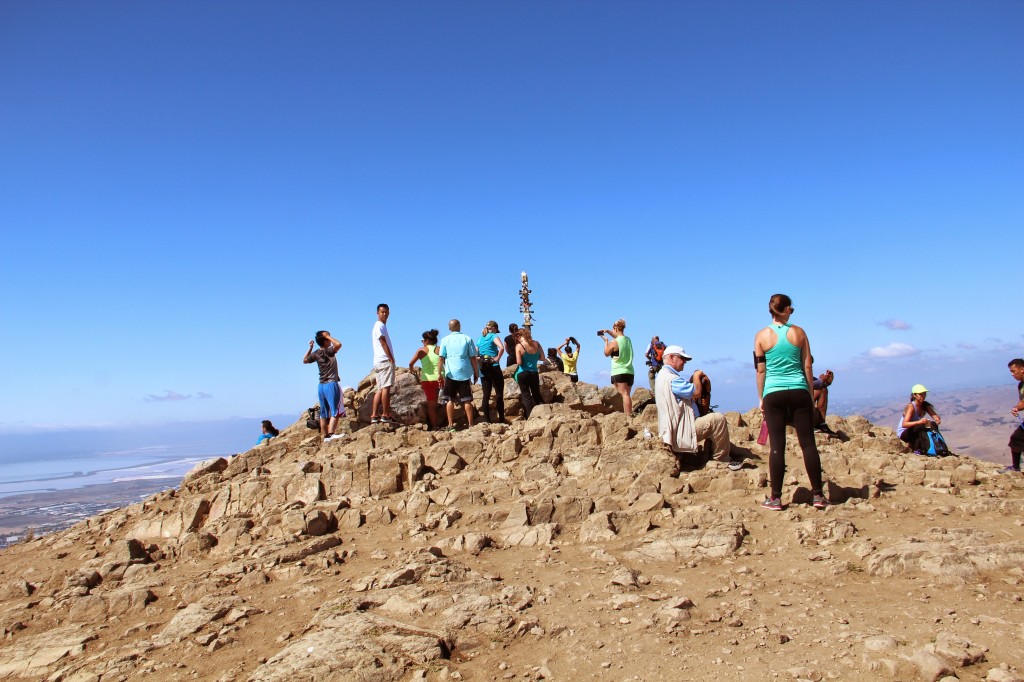
Lakshmi Sarah is an educator and reporter. She is a student at the UC Berkeley Graduate School of Journalism focusing on environmental issues.

